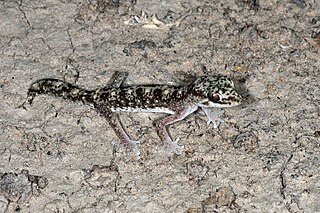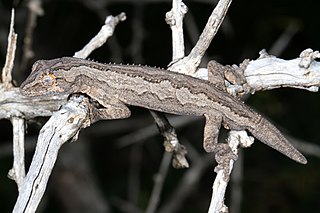
Diplodactylus is a genus of geckos of the family Diplodactylidae from Australia. They are sometimes called stone geckos or fat-tailed geckos. Member species are morphologically similar but genetically distinct.

The beaded gecko is a gecko endemic to Australia.
The western beaked gecko is a species of gecko found throughout the interior of Australia.

Diplodactylinae is a subfamily in the family Diplodactylidae sensu lato. In some classifications, it is equivalent to family Diplodactylidae, which is in the infraorder Gekkota. There are 142 species in seventeen genera.

Diplodactylus vittatus, commonly known as the eastern stone gecko, stone gecko, and wood gecko, is a species of diplodactylid lizards that occurs in forest, shrubland and arid regions across Australia. It is widespread across the states of Queensland, Victoria and New South Wales, commonly found in dry peripheral bushlands. This gecko can be kept as a pet or seen within zoo enclosures.

The Carphodactylidae, informally known as the southern padless geckos, are a family of geckos, lizards in the infraorder Gekkota. The family consists of 32 described species in 7 genera, all of which are endemic to Australia. They belong to the superfamily Pygopodoidea, an ancient group of east Gondwanan geckos now only found in Australasia. Despite their well-developed limbs, molecular phylogenies have demonstrated that Carphodactylidae is the sister group to Pygopodidae, a highly specialized family of legless lizards.

The Diplodactylidae are a family in the suborder Gekkota (geckos), with over 150 species in 25 genera. These geckos occur in Australia, New Zealand, and New Caledonia. Diplodactylids are the most ecologically diverse and widespread family of geckos in both Australia and New Caledonia, and are the only family of geckos found in New Zealand. Three diplodactylid genera have recently been split into multiple new genera

Lucasium steindachneri, commonly called the box-patterned gecko or Steindachner's gecko, is a species of nocturnal, medium-sized lizard in the family Diplodactylidae. The species has a pale strip with three patches of brown along its back. This gecko is terrestrial and only found in arid and semi-arid areas of continental Australia.

Lucasium stenodactylum, also known as the crowned gecko or pale-snouted ground gecko, is a species of gecko from Australia.

Diplodactylus tessellatus, commonly known as the tessellated gecko, is a small terrestrial lizard found distributed in inland New South Wales, Queensland, Northern Territory, South Australia and the north western corner of Victoria. The tessellated gecko is one of 26 species in the genus Diplodactylus all of which are confined to continental Australia. A small gecko varying in colour from grey to rich reddish-brown with a highly variable dorsal pattern.

Strophurus intermedius, also known commonly as the eastern spiny-tailed gecko or the southern spiny-tailed gecko, is a species of lizard in the family Diplodactylidae. The species is endemic to semi-arid regions of Australia in New South Wales, Northern Territory, South Australia, Victoria and Western Australia, in mallee shrubland and woodland habitats.

The variable fat-tailed gecko or burrow-plug gecko is a diplodactylid gecko endemic to central and arid inland areas of Australia. Widespread across the continent, the variable fat-tailed is most commonly found in sandy desert habitats dominated by Spinifex grasses. They have also been bred in captivity by zoos and as pets.

Lucasium is a genus of lizards, sometimes called ground geckos, in the family Diplodactylidae. The genus is endemic to Australia, and it includes 14 species.

Main's ground gecko is a species of gecko, a lizard in the family Diplodactylidae. The species is endemic to Australia.
The short-tailed striped gecko, also known commonly as McMillan's spiny-tailed gecko, is a species of lizard in the family Diplodactylidae. The species is endemic to Australia.

The Exmouth spiny-tailed gecko, also known commonly as Rankin's spiny-tailed gecko, is a species of lizard in the family Diplodactylidae. The species is endemic to Western Australia.

Strophurus taenicauda, also known commonly as the golden spiny-tailed gecko or the golden-tailed gecko, is a species of lizard in the family Diplodactylidae. The species is endemic to eastern Australia. Three subspecies are recognized.

Strophurus williamsi, also known commonly as the eastern spiny-tailed gecko, the soft-spined gecko, and Williams' spiny-tailed gecko, is a species of lizard in the family Diplodactylidae. The species is endemic to semi-arid regions of eastern Australia including Queensland, New South Wales, Victoria and South Australia. it has become a popular species as a pet for its distinctive tail features. S.williamsi has been grouped within a clade of seven other species that are believed to have diverged from their ancestors around 16 million years ago S.williamsi can be distinguished from closer relatives by arboreality and diurnal (day-active) activity.
The gibber earless dragon, also known as the smooth-snouted earless dragon, is a species of agamid lizard endemic to Australia. It is one of a documented species of the genus Tympanocryptis, a group of small terrestrial lizards that feed off invertebrates and are characterised by the absence of an external ear structure.













